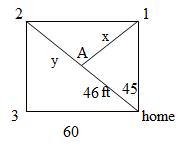
Little League Baseball Field According to Little League baseball official regulations, the diamond is a square 60 feet on a side. The pitching rubber is located 46 feet from home plate on a line joining home plate and second base.
a. How far is it from the pitching rubber to first base?
b. How far is it from the pitching rubber to second base?
c. If a pitcher faces home plate, through what angle does he need to turn to face first base?
To find:
a. How far is it from the pitching rubber to first base?
Answer to Problem 48AYU
a. The pitching rubber is feet from the base.
Explanation of Solution
Given:
According to Little League baseball official regulations, the diamond is a square 60 feet on a side. The pitching rubber is located 46 feet from home plate on a line joining home plate and second base.
Formula used:
Calculation:

a. To find how far is it from the pitching rubber to first base, we need to find .
and
feet.
The pitching rubber is feet from the base.
To find:
b. How far is it from the pitching rubber to second base?
Answer to Problem 48AYU
b. The pitching rubber is at a distance of feet from the second base.
Explanation of Solution
Given:
According to Little League baseball official regulations, the diamond is a square 60 feet on a side. The pitching rubber is located 46 feet from home plate on a line joining home plate and second base.
Formula used:
Calculation:

b. To find how far is it from the pitching rubber to second base, we need to find .
and
feet.
The pitching rubber is at a distance of feet from the second base.
To find:
c. If a pitcher faces home plate, through what angle does he need to turn to face first base?
Answer to Problem 48AYU
c. The pitcher needs to turn at an angle of .
Explanation of Solution
Given:
According to Little League baseball official regulations, the diamond is a square 60 feet on a side. The pitching rubber is located 46 feet from home plate on a line joining home plate and second base.
Formula used:
Calculation:

c. we need to find angle .
The pitcher needs to turn at an angle of .
Chapter 8 Solutions
Precalculus
Additional Math Textbook Solutions
Basic Business Statistics, Student Value Edition
A Problem Solving Approach To Mathematics For Elementary School Teachers (13th Edition)
Elementary Statistics: Picturing the World (7th Edition)
University Calculus: Early Transcendentals (4th Edition)
Thinking Mathematically (6th Edition)
- please do Q3arrow_forwardUse the properties of logarithms, given that In(2) = 0.6931 and In(3) = 1.0986, to approximate the logarithm. Use a calculator to confirm your approximations. (Round your answers to four decimal places.) (a) In(0.75) (b) In(24) (c) In(18) 1 (d) In ≈ 2 72arrow_forwardFind the indefinite integral. (Remember the constant of integration.) √tan(8x) tan(8x) sec²(8x) dxarrow_forward
- Find the indefinite integral by making a change of variables. (Remember the constant of integration.) √(x+4) 4)√6-x dxarrow_forwarda -> f(x) = f(x) = [x] show that whether f is continuous function or not(by using theorem) Muslim_mathsarrow_forwardUse Green's Theorem to evaluate F. dr, where F = (√+4y, 2x + √√) and C consists of the arc of the curve y = 4x - x² from (0,0) to (4,0) and the line segment from (4,0) to (0,0).arrow_forward
- Evaluate F. dr where F(x, y, z) = (2yz cos(xyz), 2xzcos(xyz), 2xy cos(xyz)) and C is the line π 1 1 segment starting at the point (8, ' and ending at the point (3, 2 3'6arrow_forwardCan you help me find the result of an integral + a 炉[メをメ +炉なarrow_forward2 a Can you help me find the result of an integral a 아 x² dxarrow_forward
 Calculus: Early TranscendentalsCalculusISBN:9781285741550Author:James StewartPublisher:Cengage Learning
Calculus: Early TranscendentalsCalculusISBN:9781285741550Author:James StewartPublisher:Cengage Learning Thomas' Calculus (14th Edition)CalculusISBN:9780134438986Author:Joel R. Hass, Christopher E. Heil, Maurice D. WeirPublisher:PEARSON
Thomas' Calculus (14th Edition)CalculusISBN:9780134438986Author:Joel R. Hass, Christopher E. Heil, Maurice D. WeirPublisher:PEARSON Calculus: Early Transcendentals (3rd Edition)CalculusISBN:9780134763644Author:William L. Briggs, Lyle Cochran, Bernard Gillett, Eric SchulzPublisher:PEARSON
Calculus: Early Transcendentals (3rd Edition)CalculusISBN:9780134763644Author:William L. Briggs, Lyle Cochran, Bernard Gillett, Eric SchulzPublisher:PEARSON Calculus: Early TranscendentalsCalculusISBN:9781319050740Author:Jon Rogawski, Colin Adams, Robert FranzosaPublisher:W. H. Freeman
Calculus: Early TranscendentalsCalculusISBN:9781319050740Author:Jon Rogawski, Colin Adams, Robert FranzosaPublisher:W. H. Freeman
 Calculus: Early Transcendental FunctionsCalculusISBN:9781337552516Author:Ron Larson, Bruce H. EdwardsPublisher:Cengage Learning
Calculus: Early Transcendental FunctionsCalculusISBN:9781337552516Author:Ron Larson, Bruce H. EdwardsPublisher:Cengage Learning





